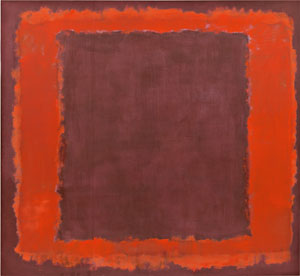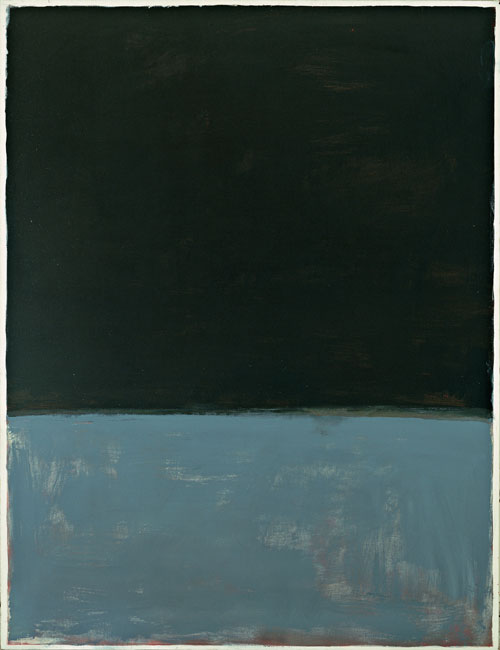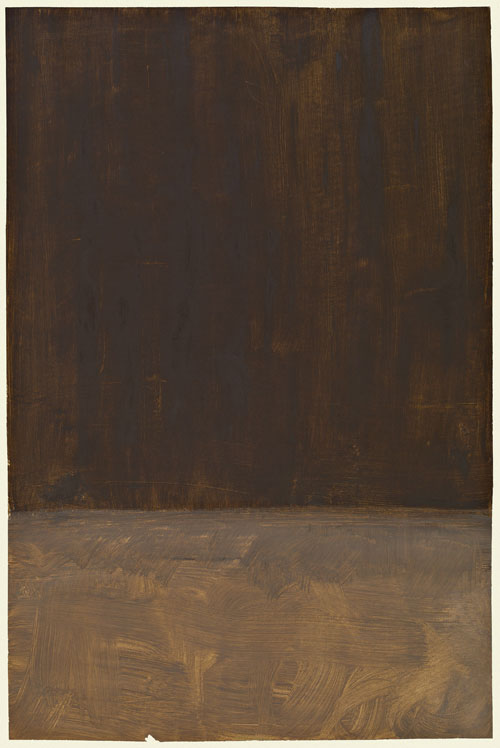
There are 14 oversized murals here, slowly coming into focus in the dim light, each playing off the other, drenched in colors and shapes that seem to vibrate.
The effect is powerful but not troubling.
For the first time, Mark Rothko’s ‘Seagram’ murals are on display together at a Tate Modern exhibit of his dark, brooding later works.
The murals – usually scattered in museums in London, Washington D.C., and Sakura, Japan – were originally part of a series commissioned for display at New York’s Four Seasons restaurant in New York’s landmark Seagram building.
Rothko, a Russian-American celebrated as one of the greatest painters of the 20th century, had a change of heart and backed out of the commission, returning the money he had been paid.
Many art historians believe that Rothko, who had left-wing political views, opted out because he was uncomfortable with the restaurant’s status as an elite gathering place for the wealthiest New Yorkers.
The Tate Modern said the artist and his wife dined at the restaurant in the summer of 1959 after returning from a trip to Europe and were “horrified” by the ostentation. He withdrew from the commission several months later.
The series of 30 canvases he was considering for the Four Seasons has never been displayed in a single place, but Tate Modern has gathered 14 for the new show, which opens Friday, Sept. 26, 2008.
The series includes murals donated to the Tate by the artist shortly before his death as well as works on loan from the National Gallery in Washington and the Kawamura Memorial Museum of Art in Japan.
It is stunning to see the brooding, mysterious works in one room, and to see the other masterworks on display at the new exhibition, which was shown to the media Wednesday by Christopher Rothko, the artist’s son, and Achim Borchardt-Hume, the museum’s curator of modern and contemporary art.
Christopher Rothko seemed overwhelmed by the sight of so many of his father’s large murals finally displayed as a series.
“Seeing them on the wall, seeing them juxtaposed against one another, they completely change and they take on new lives all the time and seeing that kind of change occur, seeing them come to life, is very exciting,” he said. “The Seagram murals are really as deep and as focused as anything he was going to produce.”
Mark Rothko was often associated with bright, luminous colors, but his later work used a much darker palette, including paintings that are primarily black and gray. The new show includes not only the vibrant Seagram murals, but also the renowned but far more muted Black-Form paintings from 1964 and examples of his final series, the Black on Gray works from 1969 and 1970.
Christopher Rothko said he hopes his father’s legions of admirers will come see the later works.
“To me the late ’50s and through the ’60s were the richest period of my father’s work, and in some ways the least understood,” he said. “I hope people will come and see just how vibrant these paintings are and that even as they become darker they are still full of light and vigor.”
There are more than 50 of the artist’s works on display, including paintings and works on paper. The museum devotes a large amount of space to the Rothko exhibit, allowing one large painting, Four Darks in Red from 1958, to be displayed on its own in an otherwise empty room, as the artist wanted.
Curator Borchardt-Hume said a number of myths had long surrounded the Seagram murals, which were commissioned in 1958. They were intended to provide the crowning glory to the Seagram building by providing its exclusive restaurant a series of works by America’s most accomplished artist, he said.
“They only wanted seven murals but Rothko over the course of little more than a year made 30 paintings,” said Borchardt-Hume. “This shows how invested he was in this project.”
He said Mark Rothko kept the paintings for years after he canceled the commission when he could easily has sold them.
“They very clearly occupied a key position in his thinking about his work,” Borchardt-Hume said. “They were always supposed to be seen as a series, and this is the thinking that underpins the exhibition.”
The artist, who was suffering from depression and a variety of other serious health problems, committed suicide in 1970.
The exhibit, titled Rothko, opens Sept. 26 and runs until Feb. 1, 2009.
Copyright 2008 Associated Press. All rights reserved. This material may not be published, broadcast, rewritten, or redistributed.
AP-CS-09-24-08 1301EDT
ADDITIONAL LOTS OF NOTE




